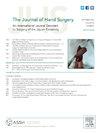The Scope and Distribution of Upper Extremity Nerve Injuries Associated With Combat-Related Extremity Limb Salvage
IF 2.1
2区 医学
Q2 ORTHOPEDICS
引用次数: 0
Abstract
Purpose
Chronic pain and functional limitations secondary to nerve injuries are a major barrier to optimal recovery for patients following high-energy extremity trauma. Given the associated skeletal and soft tissue management challenges in the polytraumatized patient, concomitant nerve injuries may be overlooked or managed in delayed fashion. Whereas previous literature has reported rates of peripheral nerve injuries at <10% in the setting of high-energy extremity trauma, in our experience, the incidence of these injuries has been much higher. Thus, we sought to define the incidence, pain sequelae, and functional outcomes following upper extremity peripheral nerve injuries in the combat-related limb salvage population.
Methods
We performed a retrospective review of all patients who underwent limb salvage procedures to include flap coverage for combat-related upper extremity trauma at a single institution between January 2011 and January 2020. We collected data on patient demographics; perioperative complications; location of nerve injuries; surgical interventions; chronic pain; and subjective, patient-reported functional limitations.
Results
A total of 45 patients underwent flap procedures on 49 upper extremities following combat-related trauma. All patients were male with a median age of 27 years, and 96% (n = 47) of injuries were sustained from a blast mechanism. Thirty-three of the 49 extremities (67%) sustained associated nerve injuries. The most commonly injured nerve was the ulnar (51%), followed by median (30%) and radial/posterior interosseous (19%). Of the 33 extremities with nerve injuries, 18 (55%) underwent surgical intervention. Nerve repair/reconstruction was the most common procedure (67%), followed by targeted muscle reinnervation (TMR, 17%). Chronic pain and functional limitation were common following nerve injury.
Conclusions
Upper extremity peripheral nerve injury is common following high-energy combat-related trauma with high rates of chronic pain and functional limitations. Surgeons performing limb salvage procedures to include flap coverage should anticipate associated peripheral nerve injuries and be prepared to repair or reconstruct the injured nerves, when feasible.
Type of study/level of evidence
Therapeutic IV.
与战斗相关的肢体抢救中上肢神经损伤的范围和分布情况
目的 继发于神经损伤的慢性疼痛和功能限制是高能量四肢创伤患者实现最佳康复的主要障碍。鉴于多发性创伤患者的骨骼和软组织管理面临挑战,伴随的神经损伤可能会被忽视或延迟处理。之前有文献报道,在高能量四肢创伤的情况下,周围神经损伤的发生率为 10%,而根据我们的经验,这些损伤的发生率要高得多。因此,我们试图确定与战斗相关的肢体救治人群中上肢周围神经损伤的发生率、疼痛后遗症和功能预后。方法我们对 2011 年 1 月至 2020 年 1 月期间在一家机构接受肢体救治手术的所有患者进行了回顾性审查,其中包括因与战斗相关的上肢创伤而接受皮瓣覆盖的患者。我们收集了患者人口统计学、围手术期并发症、神经损伤位置、手术干预、慢性疼痛以及患者主观报告的功能限制等方面的数据。 结果 共有45名患者在与战斗有关的创伤后接受了49个上肢的皮瓣手术。所有患者均为男性,中位年龄为 27 岁,96%(n = 47)的损伤是由爆炸机制造成的。49 例上肢中有 33 例(67%)伴有神经损伤。最常见的受伤神经是尺神经(51%),其次是正中神经(30%)和桡神经/骨间后神经(19%)。在 33 例神经损伤的肢体中,有 18 例(55%)接受了手术治疗。神经修复/重建是最常见的手术(67%),其次是靶向肌肉神经再支配(TMR,17%)。结论上肢周围神经损伤在高能量战斗相关创伤后很常见,慢性疼痛和功能受限的发生率很高。外科医生在进行包括皮瓣覆盖在内的肢体挽救手术时,应预计到相关的周围神经损伤,并在可行的情况下做好修复或重建损伤神经的准备。
本文章由计算机程序翻译,如有差异,请以英文原文为准。
求助全文
约1分钟内获得全文
求助全文
来源期刊
CiteScore
3.20
自引率
10.50%
发文量
402
审稿时长
12 weeks
期刊介绍:
The Journal of Hand Surgery publishes original, peer-reviewed articles related to the pathophysiology, diagnosis, and treatment of diseases and conditions of the upper extremity; these include both clinical and basic science studies, along with case reports. Special features include Review Articles (including Current Concepts and The Hand Surgery Landscape), Reviews of Books and Media, and Letters to the Editor.

 求助内容:
求助内容: 应助结果提醒方式:
应助结果提醒方式:


